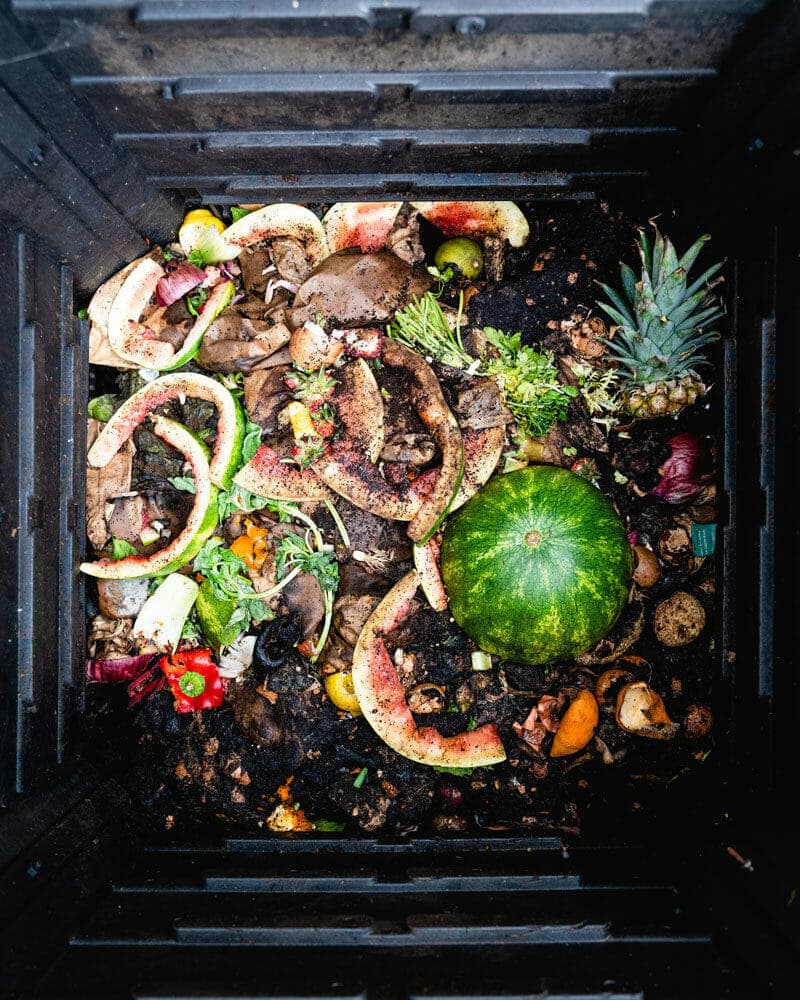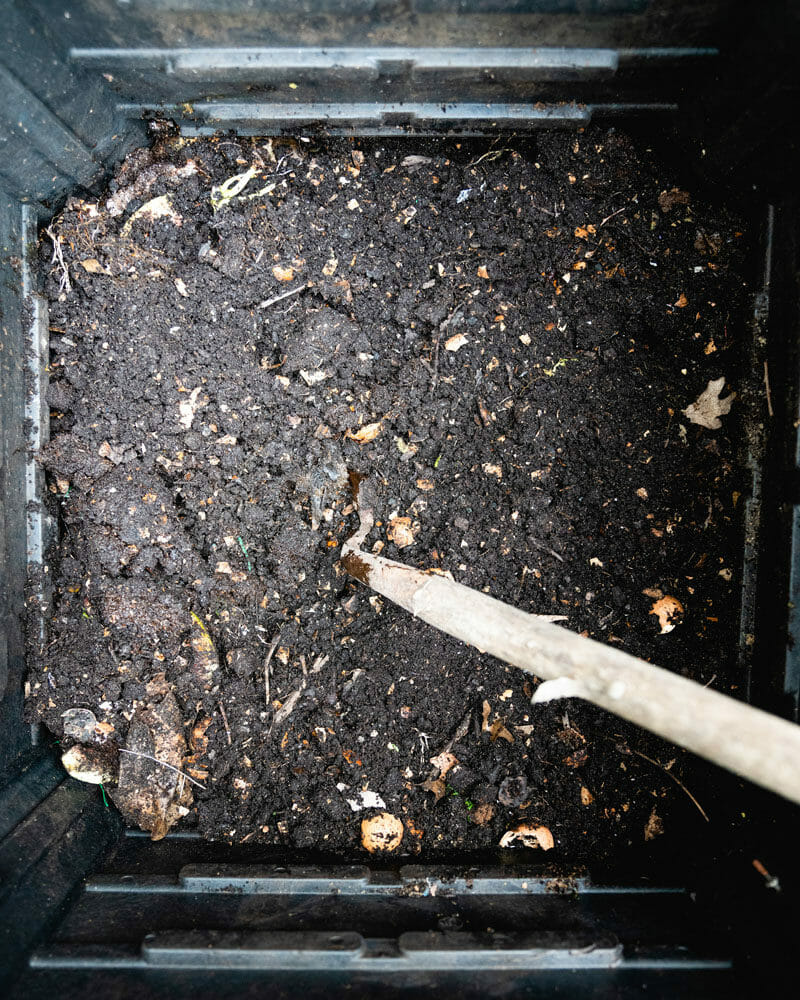Wondering what to do with all those banana peels, coffee grounds, and onion skins from your kitchen adventures? Compost, of course! Here’s how to compost.

Wondering what to do with all those banana peels, onion skins, coffee grounds, and basil stems from all your kitchen adventures? Compost — of course! If you have any sort of green space (or even potted plants!), it’s well worth your time. Compost is one of the best ways to keep your soil healthy and full of nutrients. In addition, by adding most of your food scraps to the compost (and assuming you recycle), you’ll have very little trash!
Related: How to Grow Herbs

Why compost?
If you have even a slight interest in how to compost, you should definitely start a pile. I truly love ours (weird, I know). When I finally produced some compost last year for the first time, I thought someone had thrown some dirt into my bin. It took me several seconds to realize that the “dirt” was the compost I had been waiting for!
With our square foot garden, we add a couple of scoops of the finished compost after we harvest each square. Using this method, we are able to keep our raised-bed garden nutrient-filled and ready for the next planting. Best of all, it’s completely organic and chemical free! Ready to get going?

How to compost
1. Find a compost bin (and pail).
You can use just about anything to hold your compost – from a plain heap to a box made from scrap pallets. For city-dwellers like us, use a pre-made bin with a locking lid. Here’s the bin we use: Classic Compost Bin $79
If you are wondering about those cool tumbler-style composters, they aren’t really necessary for beginners. They do a great job of speeding up the process – but are probably better suited for an expanded (rather than new) operation.
For collecting food scraps in your kitchen, you can also use just about any type of covered container. We use a stainless steel compost pail built especially for the task: it also has a filter to minimize odors. And it looks great on the counter! Stainless Steel Compost Pail with Filter $22
2. Add to the pile: 50/50 greens and browns.
You can add any plant-based material to the pile – the more variety, the better! You want to keep the mix roughly 50/50 “greens” and “browns”. “Greens” are items that will compost quickly – such as kitchen scraps and coffee grounds. “Browns” are heavier and slower to decompose — such as fallen leaves, shredded paper, or sawdust. Don’t worry too much about the mix – it will all turn into compost eventually!
3. Do not add these items!
DO NOT add any meat, dairy, fats, or dog poo to the pile. These will create smells, attract pests, and add nothing good to your pile! We also avoid placing anything cooked into the pile.
4. Mix weekly.
Take a shovel to the pile and move it around about once a week — this speeds up the composting process from months to weeks. It also allows much-needed oxygen to get in and alleviate stinky bacteria. While you are at it, make sure to break up any larger items in the pile. The smaller the kitchen scraps and yard waste, the quicker they will decompose.
5. Enjoy your compost!
All of a sudden, all of that junk turns into dirt! The amount of time varies depending on the time of year, size of pile, and frequency of mixing. Remove some of the compost and add it to your garden beds for the best organic fertilizer your plants have ever seen!

And that’s how to compost!
How about you? Have you tried it? Do you have any tips? Let us know in the comments below.

Related
We love to provide resources for your kitchen and garden! Here are a few more of our resources:
- How to Grow Herbs
- How to Organize Your Spices…the Minimalist Way
- How to Grow Basil | Harvest Basil | Store Fresh Basil
- Cove Dishwasher: “Cleanest They’ve Ever Been”
- How to Replace a Garbage Disposal
- How to Give Your Pantry a Healthy Makeover
- DIY Gold Painted Herb Pots
- How to Care for Butcher Block Countertops




Don’t forget to water it! And the more sun it recieves the better :)
Good point! Keep the pile moist and the warmer it is, the faster it will compost!
May I suggest before composting your vegetable, and even some fruit, scraps (uncooked only) that you freeze them in a zip-lock bag or tupperware to make vegetable stock with. I usually save enough to fill a very large pot about 3/4ths of the way up. From there I add water up to a level to just cover the scraps. Then I add a few bay leaves, peppercorns and a pinch of salt. Bring all of this to a boil and then turn down to a simmer for an hour – stirring occasionally. Strain out the organic material for composting and keep the liquid for use in just about anything. I love doing pasta with it as it adds a ton of flavor. I also recommend freezing the stock in ice cube trays – that way you can just pop-out the amount you need and let it defrost (as opposed to having to defrost a whole big thing of stock).
Great idea! We’ve got our own recipe right here (not that your method doesn’t sound great): https://www.acouplecooks.com/2011/03/vegetable-broth/
For some reason, I thought you couldn’t compost the left-over material from making stock – but maybe only if it has meat in it? Thanks for sharing!
While you can compost the leftovers from stocks/broths with meat in them I would not recommend it for reasons listed in the main post (smell/pests). I am talking about purely vegetable stock – the leftovers from making this breakdown quickly as they’ve been heated in water too.
Awesome. Good to know.
Alex, the childhood photos are great- things really do come full circle, don’t they?
:) Brainwashing your children does work!
Great (com)post! I would really like to get started composting. Thanks for making it sound do-able! I’m wondering though… how does compost do in the winter? Would it make sense for me to start now, or wait for spring to roll around again?
It’s actually a great time to start. If you have any falling leaves – they make great “browns” for the compost and you can add any plants that are coming out of your garden (if you have one). A lot of people actually save their leaves to add throughout the year.
The actual composting process will slow down quite a bit through the winter, but you’ll be set for a quick start in the spring.
Ben:
I really (really, really, really) understand the “I truly love ours” statement. It is absolutely amazing to throw garbage into a bin and have dirt for the garden. Even more fun is red worms eating your garbage (unfortunately I live in an area that gets triple digit temps in the summer with no way to keep the warms cool enough that they don’t poach).
In addition to no dog poo, let me just add NO KITTY LITTER either . . . too much chance of disease being carried in the litter . . . plus, litter is clay, why would anyone purposely add clay to their garden? ;-)
I am on my second tumbler composter. The ones that are the most expensive (the green ones, not the ones made from recycled materials) actually rust out after a few years. I have gotten both of mine through free cycle, so I have no complaints, but my next “tumbler” will be one of the black plastic recycled ones. It does make the turning a lot easier . . . but they are much more expensive than the box types.
Also, gardeners should check with their local government. Our county sells compost bins at a discount price to local residents.
Thanks for a great (com)post!
I am so, so glad you posted about this. Composting is one thing that we don’t do yet but I am very eager to start. My family composted while I was growing up (and still does), but we had a yard with tons of trees, and therefore lots of leaves to add to the pile. Our current home is in a newer neighborhood so we don’t have many mature trees and very few leaves, so I thought composting was not an option for us. If we can add shredded paper for the “browns” that would definitely work for us. I’m going to pursue this. Thank you!!
I’m glad you’re excited to start. Few mature trees means plenty of sunlight for gardening!
This website says to avoid shiny/colorful paper like ads and can labels, fyi: http://compostingtips.info/composting-paper/
If you ever want to come into Broad Ripple to get some leaves to-go, we’ve got plenty to share :)
If you don’t have the space or set-up to enable you to regularly turn your compost you can ensure a good flow of oxygen by putting in a piece of pvc pipe with holes drilled in it and building your heap around it.
Does this work well? I’ve always wondered about that technique.
I’ve got two bins constantly cycling and it works a treat. Much faster than the anaerobic method but not as good as regular turning (of course). Sadly I just don’t have the space for that kind of set-up.
Great! Thanks for the info.
Erin, what kind of bins do you use?